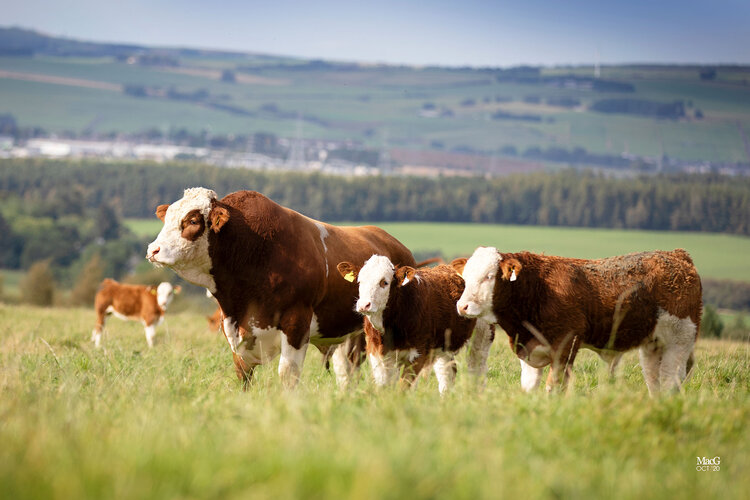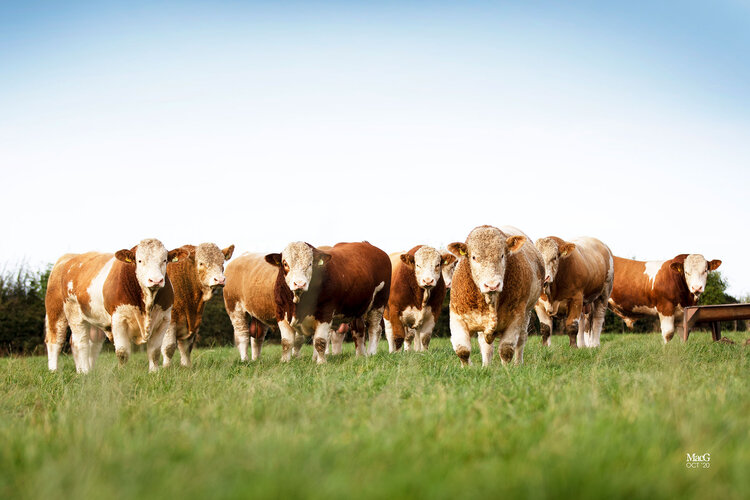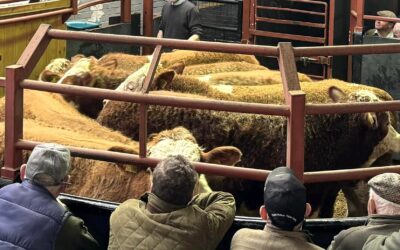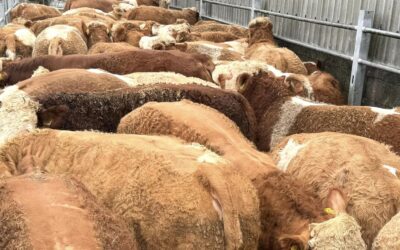LOCKERBIE; LANARK; EXETER; DUMFRIES; SWATRAGH; SHREWSBURY; MELTON MOWBRAY; STIRLING; MARKET DRAYTON; BAKEWELL; SKIPTON; THAINSTONE; LUDLOW; THAME; FROME; HUNTLY; AND CARLISLE We continue to feature Simmental sired cattle doing the business, but please note there’s...
ADDED VALUE SIMMENTALS TOPPING MARKETS AROUND THE UK AND INCLUDING AT:
THAINSTONE; BALLYMENA; STIRLING; CARLISLE; FROME; SKIPTON; TRURO; SEDGEMOOR; AYR; PRESTON; SALISBURY; DALMALLY; GISBURN; EXETER; LUDLOW; MARKET DRAYTON; & DUNGANNON Some soaring trades for all classes of cattle at livestock markets around the UK and with Simmental...
MODERN, VERSATILE OVERHILL HOUSE SIMMENTALS PROVING TO BE THE WHOLE PACKAGE
It’s been a record-breaking year to remember for Overhill House Simmentals and owner Richard McCulloch, Armadale, West Lothian. Here we profile the 130-cow herd, look at it’s history, and some of the breeding philosophies behind its ongoing progress and development....
SIMMENTALS AT THE HEART OF THE SIMMERS FAMILY LARGE-SCALE CATTLE ENTERPRISE
Feature on the pedigree and commercial cattle enterprise, comprising some 600 cows, of the Simmers family, Backmuir Farm, Keith, Banffshire.

Over the past seven years, the Simmers family have transformed their large-scale cattle enterprise by moving to a closed herd and breeding their own replacements, with Simmentals at the forefront of this new streamlined system.
The farming business runs in conjunction with the family’s livestock trading business and construction company, with Philip Simmers working in partnership with his brother Symon and alongside his sons, Reece and Andrew. Within the mixed farming enterprise, based between Backmuir, at Keith, Morayshire, and Oldmeldrum in Aberdeenshire, they grow 2500 acres of cereals and run 600 cows.
Previously, Limousin and Blue cross Friesian heifers were bought in to form the basis of the suckler herd, but a diminishing availability of those type of females led to the decision to change entire system. Philip explains: “We were struggling to get the numbers and type of heifers that we wanted, so we revaluated the whole system and decided to make changes. We used to sell suckled calves, but we decided to go entirely beef bred and start finishing all our own cattle. We started buying Sim-Luings and were really impressed with them – they’re efficient, hard-working cows, with minimal calving difficulties.”
The success with the Sim-Luings resulted in the Simmers establishing their own pure Luing and Simmental herds, in order to breed their own replacements. There are now 200 pure Luings, with some of those bred pure and some to the Simmental, and the family’s Backmuir Simmental herd of 50 cows. The rest of the herd is made up of Sim-Luings, which currently go to the Simmental or the Charolais bull.

“The Sim-Luings maintain their condition all year; they are easy fleshing and they pass that onto their offspring, whatever they are crossed with. We’re moving towards using entirely Simmental bulls on the Sim-Luings because we’ve been finding a big demand for the females,” says Philip.
For the number of females, 30 bulls are needed at any one time, and the Simmers are not afraid to spend big to get the bulls they want. Current bulls include Islavale Hamilton, Islavale Imperial and Corrick Hayden, while the new additions in February 2020, where Philip judged the pre-sale show, were the overall champion, Wolfstar Jackaroo at 18,000gns and the reserve senior champion, Wolfstar Jimmy Choo at 17,000gns. Earlier this month in a private sale, the herd bought Lisglass Kirk, a twenty-month-old son of Mullyknock Gallant, for £25,000 from Leslie and Christopher Weatherup, Co Antrim, a breed record for a bull bred in Northern Ireland.
“If we see something we like, then we try to buy it – we’ve never regretted paying a bit more to get a better quality bull, because we find they pay their way in the long-run. We’re looking for the same type of bull for the commercial and pedigree herds – long, with a good top and bottom line, good plates, a good, square back-end, correct on their legs, with character of the head.”
The cows run at the Simmers’ farms at Keith – they are batched as young heifers and tend to run in those same groups their whole lives. Bulls go out on June 1st for 10 weeks and Philip says that since switching breeds, 60% of the cows calve in the first cycle, with that number increasing all the time.
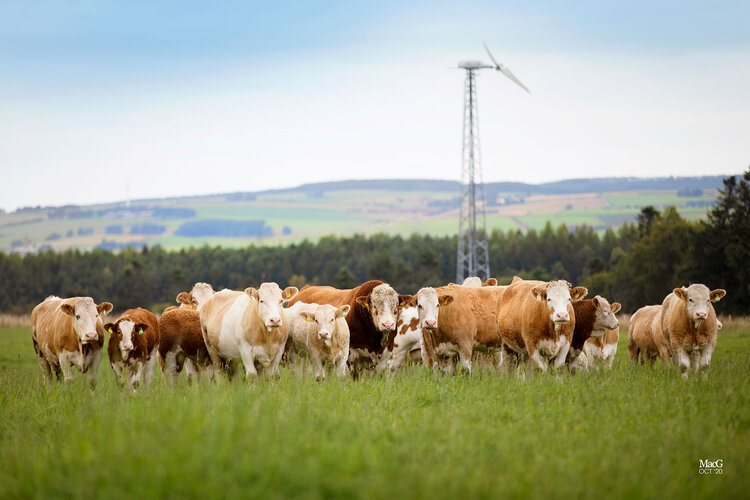
He adds: “The Sim-Luings are easily kept through the winter. They are housed purely because our ground conditions do not allow for them to be kept out, but they maintain their fitness all year and because of this, they calve easily. There’s a fine balance to make sure they’re not over-fat, but for us, they certainly need to be in good condition at calving time to ensure fewer problems.
“Heifers are calved from 30 months onwards, which again, works for our system. We find if we let them grow on naturally and don’t push them when they’re young, then they last a lot longer, are better on their feet and legs and have fewer problems as they get older.” The majority of the cattle calve in the spring on straw bedded courts and are put back outside as soon as possible. Calves are vaccinated for lungworm at the end of July and are weaned at the end of October, having had no creep feed up until that point.
Philip explains: “We went from taking two cuts of silage to just one cut and the cows and calves go onto the silage aftermath. The biggest daily liveweight gain in the calves is when they’re with their mothers on good grass, with plenty milk. It’s better for the farm in general too and we’re using less fertiliser.” At the end of October, the calves are penned and fed on a silage and grain diet with supplement protein. They remain on that, with barley increasing on a monthly basis. Bull calves, which are all left entire, receive a more intensive grain diet for the last 8-10 weeks, while any heifers that are not being retained for breeding go on an ad-lib cereal-based diet for 8-10 weeks from the middle of May.
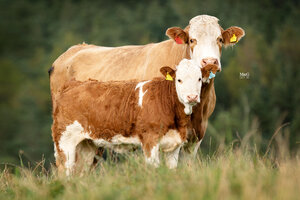
“The silage-based diet helps them to grow and then the grain puts the weight on. All last year’s spring calves had left the farm by August of the following year, with bulls averaging 390kg d/w selling to Highland Meats, while heifers average between 350kg and 380kg d/w,” says Philip.” The heifers being retained for breeding receive a silage and straw diet with minerals and a little supplement grain in the first winter, and then only silage and straw.
Philip adds: “We try not to give those heifers much grain at all as we find they last longer and have fewer problems when they’re allowed to grow naturally. It also means they are fairly cheap to keep over the two winters until they calve.”
Depending on how many females are being kept, the team normally finish 500 calves annually, all on home-grown feeding, with only protein and minerals bought in. In addition to the feed barley, they also grow 2000 acres of malting barley each year, with all land work carried out in-house since 2010 by the team of six full-time staff across the cereals and livestock.
“With the reduction in staff nowadays, the cows really have to be able to look after themselves the majority of the time. In our experience, with the Sim-Luings we are producing an ideal cow for our system,” says Philip. The team are planning towards a sale of females and bulls in 2022, which they hope to become an annual event. It will showcase just how far the businesses have come, through the family’s hard work and determination, which began with Philip and Symon’s father, Willie, who started working at Backmuir aged 14 before training as a blacksmith. He eventually went back and bought the farm that he started out at and the enterprise grew from there.
“We’ve always invested in land when we could and then paying that gives us the incentive to work harder. It’s difficult though in farming, to get a fair price for what you’re producing, so by concentrating on keeping up the quality of our females and getting our calves away as young as possible, it’s giving us the best chance of making a profit.”
An added focus for the family, has been their pedigree Simmental herd, which started in 2018 with the purchase of 20 females from the Starline herd. Another, bought as a bulling heifer, Sterling FCUK Impuls, ensured them plenty success in the showring in 2019, finishing female and reserve breed champion at the Scottish National Show at Kelso. She also won overall champion at Turriff Show; reserve female and reserve breed champion at the Royal Highland and Keith Show, and stood overall in the Scottish Beef Champion of Champions at Keith.

Aiming to breed the type of bulls that they like to buy themselves, their debut selling at Stirling in October 2020 went well, with sons of Corrick Hayden making 8000gns and 7000gns. This was followed up in February this year at Stirling when the sale second top price was 15,000gns for Backmuir Kraken 19, the first son to be sold at sale by Islavale Hamilton 16 and is out of the dam, Starline Kreole 11th. A bull with ‘good power and style, and very correct in his legs’, he headed south of the border and to the new pedigree herd of AR Bulmer, Coultas Farm, Malton, North Yorkshire.
“Our goal is to produce the best of females, as that’s what ensures results in the long term, and if we can breed some good bulls along the way, then that’s ideal,” adds Philip.
